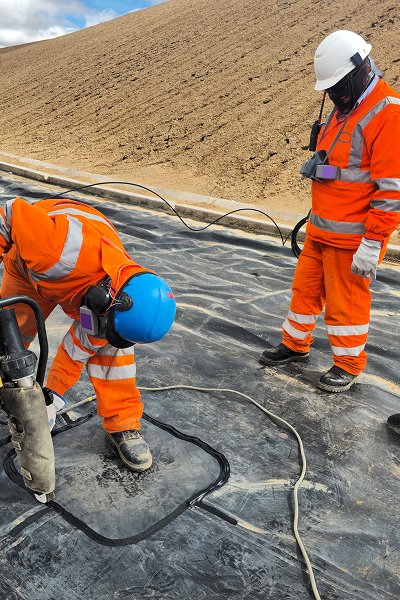Effect of mud properties on dewatering efficiency
Solids Concentration
The solids content of the slurry directly determines the efficiency of the initial dewatering phase.
When the solids content is too low (<5%), the slurry has high fluidity but low particle concentration, resulting in low filtration resistance but long dewatering times, making it difficult to quickly remove water.
When the solids content is too high (>25%), the slurry becomes viscous and has poor fluidity, which can easily lead to uneven filling of the tube bag or blockage of the feed port.
The optimal solids content range is generally between 10% and 20%, achieving a balance between fluidity and concentration. In actual projects, the optimal value can be determined through centrifuge tests or sedimentation column experiments.

Particle Size Distribution (PSD)
Particle size and distribution determine how filtration channels form:
Slurries with a high content of fine particles (<0.01 mm), such as silt or clay, form a dense filter cake, causing clogging of the filter layer.
Slurries with a high proportion of coarse particles (>0.05 mm) dewater quickly, but the resulting solids packing strength is low and prone to collapse.
Mud Viscosity and pH
High-viscosity slurries (>200 mPa·s) flow slowly within the tube bag, easily forming "dead spots" and resulting in high localized moisture content.
pH affects the reaction efficiency of flocculants. Most organic polymer flocculants work best in the pH range of 6-8.
Type and dosage of flocculant
Flocculant Types
Common types include:
Cationic polyacrylamide (CPAM): Suitable for negatively charged organic sludge (such as domestic sludge and papermaking waste);
Anionic PAM: Suitable for positively charged mineral or sandy slurries;
Non-ionic PAM: Suitable for slurries with neutral or large pH variations;
Compound polymer flocculants: Coagulants (such as PAC and FeCl₃) are added to enhance bridging.
Dosage and Reaction Time
Both excessive and insufficient flocculant can reduce dewatering efficiency:
Insufficient flocs: Flocs are not fully formed, and solid particles are lost with the water.
Excessive flocs: This increases filter resistance and slows drainage.
It is recommended to determine the optimal dosage through a beaker test (jar test), generally ranging from 1–5 g/kg dry solids. The reaction time should be maintained between 30 and 60 seconds to allow flocs to fully form before entering the bag-in-tube system.
Effect of geotextile properties on dewatering efficiency
Filter Opening Size (AOS)
The AOS (apparent opening size) determines the retention and permeability of the filter layer.
Too small an AOS results in slow drainage;
Too large an AOS results in solid particle leakage.
It is generally recommended that the AOS value be 20-30% smaller than the D85 particle size (85th percentile particle size) in the slurry to achieve a good balance between retention and permeability.
Permittivity
Fabrics with high permittivity facilitate water evaporation, but they also need to be resistant to clogging. Common ranges are:
PP woven fabric: 0.02–0.05 s⁻¹
PET filament fabric: 0.03–0.08 s⁻¹
Tensile Strength and Elongation
Tube bags are subject to significant internal pressure during the filling phase. Insufficient strength can cause rupture.
Recommended:
Tensile strength ≥ 100 kN/m
Elongation 10–20%
Chemical and UV Resistance
Prolonged exposure to sunlight, salt, and acidic and alkaline environments can cause fabrics to age and lose their effectiveness. Choose fabrics treated with UV stabilizers with a UV stability lifespan of 500 hours or longer.
Filling and stacking process
Filling Pressure and Flow Control
Filling pressure determines the expansion pattern of the tubular bag.
Too low pressure: The bag will not fully expand, resulting in insufficient dehydration area.
Too high pressure: The seams will be subjected to excessive stress, potentially causing rupture.
It is recommended to maintain a filling pressure of 30–50 kPa and a steady flow rate.
Filling Speed and Layers
Stage-based filling is crucial:
Phase 1 (50% height): Forming the initial filter layer;
Phase 2 (70–90%): Dehydration followed by a second addition to maximize volume;
Phase 3: Allowing the mixture to solidify.
Stacking and Drainage Design
When stacking multiple bags, provide drainage ditches and diversion channels. A drainage blanket or sand layer should be laid between the upper and lower layers to ensure a clear water seepage path.
Seepage Control and Foundation Stability
An unstable foundation can cause the bags to sink or tilt. It is recommended to compact the foundation and lay an HDPE anti-seepage membrane and sand cushion before laying.

Q1: How long does Geotube dewatering typically take?
A1: Depending on the slurry characteristics and flocculant used, under normal conditions, primary dewatering and the formation of transportable solids can be achieved in 7–14 days. Using a high-efficiency flocculant and appropriate filling techniques can shorten this time to 3–7 days.
Q2: How can I determine the flocculant dosage using a jar test?
A2: Using varying concentration gradients, rapidly mix in a beaker and observe floc formation, settling rate, and supernatant clarity. Select the minimum effective dosage that forms stable flocs without excessive clogging.
Q3: How should an AOS be selected?
A3: It is recommended that the AOS be less than 20–30% of the D85 particle size in the slurry to retain fine particles while ensuring water permeability. For slurries with high fines content, a smaller AOS and a coagulant aid can be used.


